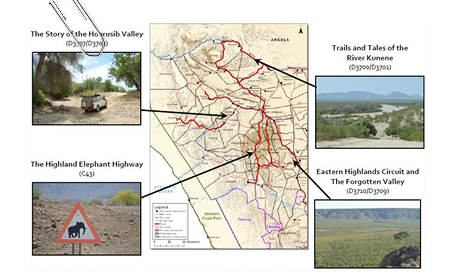IRDNC’s Kunene Northern Highlands Tourism Project
Namibia was named the top travel destination in the world and received the Wanderlust Reader Travel Award in London early this year, an award Namibia has also received in 2014. The Kunene Region of Namibia has increasingly become a tourist destination in Namibia, with mostly self-drive tourists and safari operators passing through mountainous pristine environments rich in wildlife and culture.
The entire western stretch of the Kunene Region is part of the Skeleton Coast National Park and the region also borders the world famous Etosha National Park on the east. The region is home to the Twyfelfontein World Heritage Site, Namibia’s highest peak situated in the Brandberg Mountains and the petrified forest near Khorixas. Travellers can experience the majesty of free-roaming, desert-adapted animals, ancient riverbeds and craters, Peet Alberts’ rock paintings in Kamanjab, Spitzkoppe, Epupa Waterfall and the famous “fairy circles” in Marienfluss.
Started in 2018, and co-funded by the United States Agency for International Development (USAID), the Kunene Northern Highlands Tourism Project aims at developing tourism infrastructures along the many sites of attraction Kunene has to offer. This includes developing tourist routes currently less travelled by tourists in the region and establishing new tourism income streams for local rural communities while strengthening wildlife protection across conservancies.
Numerous tourist attractions have already been identified in the Northern Highlands and are earmarked for development, including tracking of desert elephants, Himba cultural tours, mountain biking, fishing and canoeing in the Kunene River, 4x4 adventure tracks, nature trails, caving and much more. A total of 19 conservancies are anticipated to benefit from employment creation, training, creation of alternative livelihoods to livestock farming, increased commitment of local communities to wildlife protection reduction in human-wildlife conflict and overall contribution to improving the local economy in the rural areas.
The project’s next step is to market tourism activities to potential investors and donors to fundraise for development and continue detailed meetings with conservancy committees to discuss plans for tourism routes.

- IRDNC’s Kunene Northern Highlands Tourism Project



